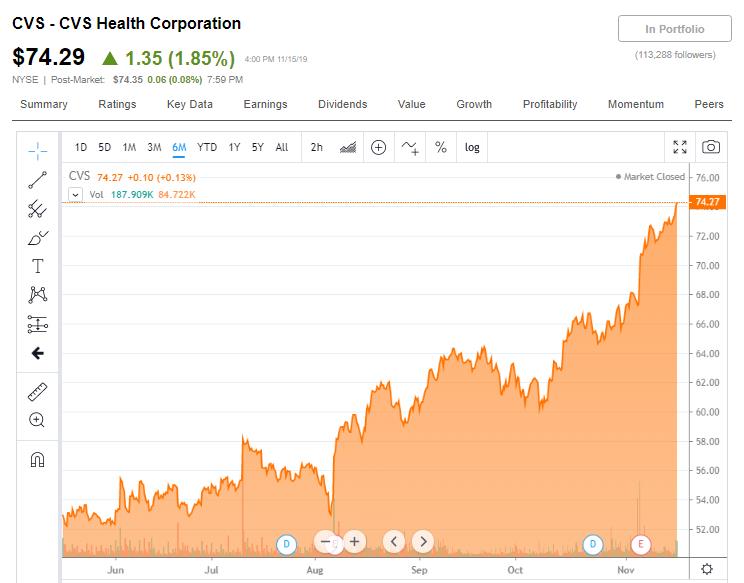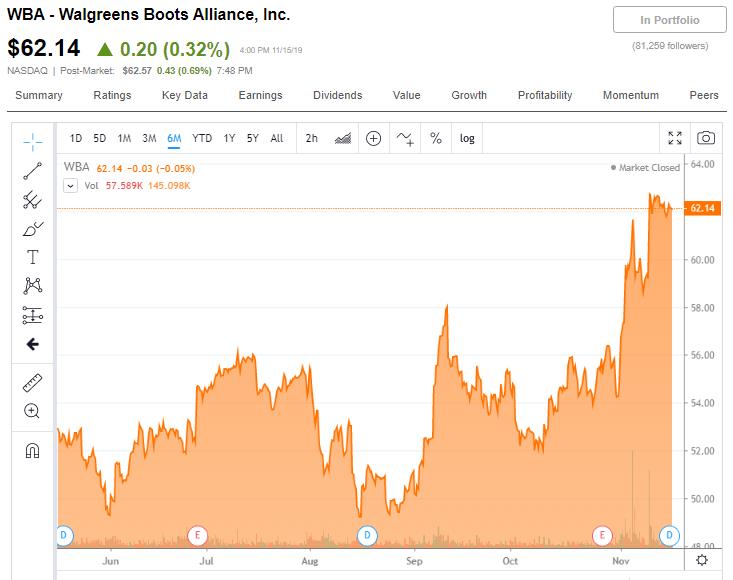CVS Health (CVS) and Walgreens Boots Alliance (WBA) have broken out recently due to a pair of better than expected quarters and speculation of being taken private, respectively. These stocks have been beaten down for years with CVS and Walgreens plummeting by 54% ($113 to $52) and 49% ($97 to $49), respectively, from their multi-year highs. Over $110 billion in combined market capitalization had been erased from these two companies. As of late, CVS has broken out to the mid $70s, and Walgreens has demonstrated strength into the low $60s, well of their respective lows.
The single-payer narrative being pushed by presidential frontrunners and the Amazon threat via its acquisitions of PillPack/Whole Foods potentially displacing traditional pharmacies weighed heavily on these companies. Additionally, drug pricing pressures are eroding margins and limiting margin expansion over time along with the secular decline in the physical storefront retail space is hindering foot traffic and same-store sales growth. The culmination of all the aforementioned factors resulted in CVS Health and Walgreens Boots Alliance being pressured in many different directions. With threats coming from all angles, these two pharmaceutical supply chain heavyweights are not only surviving but competing and reviving their dominance in the marketplace.
CVS’ Recent Rise
CVS is fresh off back-to-back quarters that have beat analysts’ expectations while generating large amounts of free cash flow, paying down debt and returning value to shareholders. To further boost long-term growth prospects, restore growth, and fend off potential competition, CVS acquired Aetna. This creates the first through-in-through healthcare company, combining CVS's pharmacies and PBM platform with Aetna's insurance business. The new CVS combines its existing pharmacy benefits manager (PBM) and retail pharmacies with the second-largest diversified healthcare company. This is a bold and hefty price tag to pay yet necessary to compete in the increasingly competitive healthcare space, changing marketplace conditions and political backdrop with drug pricing pressures. CVS is making a defensive yet necessary acquisition before it can go back on the offensive moving into the future. The acquisition will provide CVS with more scale to negotiate for better prices for the prescription drugs it sells through its PBM business.
With the enterprise synergies via the Aetna combination, the newly formed CVS is beginning to unlock value and growth over the long-term. This value creation will come through medical cost savings, membership expansion, customer retention, expanded customer value, and partnerships. This can already been seen from its recent quarterly reports. Specifically, its Q3 highlights saw Total revenues increased 36.5% to $64.8 billion, GAAP operating income increased 13.8% to $2.9 billion, operating income increased 48.9% to $3.9 billion and generating cash flow of $10.2 billion
CEO Larry Merlo stated, “As we approach the first anniversary of the Aetna acquisition, we are increasingly confident in the strength of our broad and differentiated assets as a combined company and our ability to deliver compelling value to our customers and the communities we serve. Looking ahead, we remain focused on successful execution of our strategic priorities and integration plans to unleash the full potential of our consumer-centric health care model and create value for all stakeholders."

Walgreens’ Rise
Walgreens had been on a steady rise on better than feared quarterly results and then proceeded to break out higher on speculation that the company may be taken private. Walgreens shot up on a report that KKR had approached it about a buyout with other private-equity firms showing interest. Bloomberg confirmed reports that KKR is preparing a proposal to take WBA private, although no final decisions have been made.
JPMorgan released some numbers on what a leveraged buyout of Walgreens would look like. "We believe a potential deal could be valued at up to ~$75 per WBA share, based on our assumptions around maximum lease-adjusted leverage and minimum IRR to private equity owners. We also assume an exit multiple of 10.0x forward EBITDA after five years. Using those parameters, we believe that could imply a maximum transaction value of ~$85 billion, which would imply an equity value of ~$74.97 per share."

Backdrop and Market Dynamics
The pharmaceutical supply chain cohort, specifically CVS and Walgreens, had been unable to obtain firm footing in the backdrop of consolidation within the sector, negative legislative undertones, drug pricing pressures, rising insurance costs, and a market that has lost patience with these stocks. All of these factors culminated in sub-par growth with a level of uncertainty as the sector continued to face headwinds from multiple directions. Many of the stocks that comprised this cohort presented compelling valuations in a very frothy market. This allure had been a value trap as these stocks continued to be a falling knife. It’s no secret that these companies have been faced with several headwinds that have negatively impacted the growth and the changing marketplace conditions have plagued these stocks.
The political backdrop has been a significant headwind for the entire pharmaceutical supply chain (i.e. drug manufacturers, pharmaceutical wholesalers, and pharmacies/pharmacy benefit managers). Exacerbating the political climate, the drug pricing debate continues to rage on throughout political and social media circles weighing on sector. This backdrop erodes pricing power and margins of drugs that ultimately move from drug manufacturers to patients with insurers and other middlemen playing roles in the supply chain web. In an effort to address these headwinds and restore growth, companies have made bold moves such as CVS acquiring Aetna to form one of the largest healthcare companies. Making bold acquisitions to restore growth may be the most viable means to heed competitive threats (i.e. Amazon with Pill Pack) and fend off headwinds. CVS will play an instrumental role in the future of healthcare and will have a growth platform in front of the company as healthcare spending continues to rise. Now that growth has been restored at CVS with Aneta being fully integrated to yield a fully functional bumper-to-bumper healthcare colossus; the stock has broken out.
Summary
CVS Health and Walgreens have been beaten down for years, plummeting by ~55% and ~50%, respectively, from their multi-year highs. CVS has broken out to the mid $70s, and Walgreens has demonstrated strength into the low $60s, well of their respective lows. The single-payer narrative being pushed by presidential frontrunners and the Amazon threat via its acquisitions of PillPack/Whole Foods potentially displacing traditional pharmacies weighed heavily on these companies. Additionally, drug pricing pressures are eroding margins and limiting margin expansion over time along with the secular decline in the physical storefront retail space is hindering foot traffic and same-store sales growth. The culmination of these factors resulted in CVS and Walgreens being pressured from all directions. With threats coming from all angles, these two pharmaceutical supply chain heavyweights are not only surviving but competing and reviving their dominance in the marketplace.
CVS and Walgreens presented compelling valuations in a very frothy market for a long time. This allure had been a value trap as these stocks continued to be a falling knife until recently. CVS is making a necessary yet defensive move with the acquisition of Aetna to grow its business long-term while expanding its moat to fend off competition. This combined entity is resulting in medical cost savings, membership expansion, customer retention, expanded customer value, and partnerships to drive growth and value creation. CVS is fresh off back-to-back quarters that have beat analysts’ expectations while generating large amounts of free cash flow, paying down debt and returning value to shareholders. Walgreens, on the other hand, had been on a steady rise on better than feared quarterly results and then proceeded to break out higher on speculation that the company may be taken private. JPMorgan released some numbers on what a leveraged buyout of Walgreens with "a potential deal could be valued at up to ~$75 per WBA share”.
Noah Kiedrowski
INO.com Contributor
Disclosure: The author holds shares in AAL, GE, KSS, SLB, TRIP, USO and X. He may engage in options trading in any of the underlying securities. The author has no business relationship with any companies mentioned in this article. He is not a professional financial advisor or tax professional. This article reflects his own opinions. This article is not intended to be a recommendation to buy or sell any stock or ETF mentioned. Kiedrowski is an individual investor who analyzes investment strategies and disseminates analyses. Kiedrowski encourages all investors to conduct their own research and due diligence prior to investing. Please feel free to comment and provide feedback, the author values all responses. The author is the founder of www.stockoptionsdad.com where options are a bet on where stocks won’t go, not where they will. Where high probability options trading for consistent income and risk mitigation thrives in both bull and bear markets. For more engaging, short duration options based content, visit stockoptionsdad’s YouTube channel.
